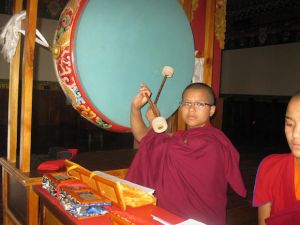Chöd: A Tibetan Buddhist Practice
Chöd (gcod), “severance” or “cutting,” is a Tibetan term referring to a cycle of Tibetan Buddhist practice and to the lineage initiated by the Tibetan woman Machik Lapdrön sometime in the 11th or 12th century. It is primarily based on the teachings of the perfection of wisdom (prajñāpāramitā) that represent the second phase of Buddhist texts that developed in India. In Tibet
itself, Chöd was one of the many new sects that flourished in the second dissemination of Buddhism from India from 950 to 1350CE. Chöd has been classified as a branch of Zhijé (zhi byed) or “Pacification,” one of the eight great practice lineages that trace
back to India, though no actual text on Chöd has been discovered in the early texts of Zhijé. Despite this quandary, its classification has afforded a kind of validation in being connected with the sources of Buddhism through the Indian master Dampa Sangyé.
Nevertheless, there is no doubt that Machik Lapdrön herself is the sole progenitor for the teachings and the lineage. This woman from the area of Lap in central Tibet was known as Lapkyi Drönma, “the Light of Lap.” The respectful title of Machik, “One Mother,” was added later and is shared with several other important women of the time, often leading to confusion. Lapdrön showed remarkable
abilities from an early age, and later gained mastery of speed reading. This led to a job as a chaplain in a patron’s house, where she met her future partner, providing her biographers with a fascinating narrative revealing the problematic status of female masters in Tibet. The recitation of prajñāpāramitā sūtras also led to her epiphany around
the parts on māra, “devil,” “demon,” or (spiritual) “death.” This, along with her visions of the bodhisattva Tārā and the important connection with the Indian master Dampa Sangyé, were the inspiration for what became one of the most widespread practices in Tibet.
The early Chöd teachings represent aspects derived from both sūtra and tantra sources. The focus is on the understanding of emptiness that severs fixation on the reification of the self and the resultant conduct based on compassion for others. The impediments that prevent such realization, called māras in Sanskrit, were a point of departure. As time went on, specific
techniques and methods of practice (sādhana) accrued to this philosophy. While the main practice has remained the cultivation of insight and the enactment of separating the consciousness from the body, the post-meditation practice known as lü jin (lus byin) “giving the body” developed elaborate visualizations and ritual accouterments that came to dominate popular practice.
Renowned as a charnel ground practice due to the visualized offering of one’s corpse as food for demons and other beings in situations that are intended to provoke fear, it is this that has become known far and wide as Chöd. The sources for
this aspect are obscure and may well come from the surrounding culture of the Tibetan plateau, harking back to Bön and other pre-Buddhist practices. Some elements associated with shamanic practices are enacted in the Chöd rituals, despite its Buddhist soteriological assertions.
With its beautiful melodies and lurid visualizations, Chöd quickly became popular in Tibet for exorcism, healing, and other practical usages. Its followers did not establish monasteries, as the lifestyle of roaming mendicants was emphasized, but Chöd was incorporated into most other schools in Tibet. Their liturgies are drawn from the works of Lapdrön’s descendants, or from visionary experiences, or found as treasure texts (terma). As of the early 21st century, Chöd has gained popularity worldwide, with many iterations in 21st-century practice.
Source
[[1]]
